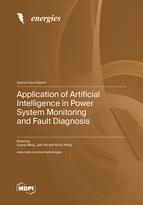Application of Artificial Intelligence in Power System Monitoring and Fault Diagnosis
A special issue of Energies (ISSN 1996-1073). This special issue belongs to the section "F5: Artificial Intelligence and Smart Energy".
Deadline for manuscript submissions: closed (31 May 2023) | Viewed by 18737
Special Issue Editors
Interests: process monitoring; fault diagnosis; fault prediction; power system modeling, control and optimization; battery energy storage systems; integrated energy systems
Special Issues, Collections and Topics in MDPI journals
Interests: battery characteristic modeling; fault diagnosis; states estimation; thermal management; energy equilibrium
Special Issues, Collections and Topics in MDPI journals
Interests: lithium battery modeling; state estimation; battery balancing; battery management system; new energy system
Special Issues, Collections and Topics in MDPI journals
Special Issue Information
Dear Colleagues,
The ever-increasing demands of automatic management in power systems and energy storage systems have been long gaining attention in industry and academia. To systematically present the recent progress in related fields, this Special Issue focuses on the advances in operation monitoring and safety controlling, most notably using emerging techniques like artificial intelligence, big data analysis, deep learning, for characteristic modeling, performance controlling and fault diagnosing applications.
The scope of this Special Issue includes but is not limited to the following:
- Data-based abnormalities analysis of thermal power system and nuclear power system;
- Fault diagnosis and prediction of wind turbines based on SCADA data;
- Modeling, monitoring and diagnosing of waste-to-energy, biomass power, and tidal power systems;
- Data-based fault characteristics analysis of power generation equipment;
- Power equipment health monitoring based on vibration signal, sound signal, image signal, thermal infrared signal, etc. ;
- Control and performance monitoring of photovoltaic power generation systems;
- Modeling, scheduling, control and monitoring of microgrid systems;
- SOC estimation, SOH estimation, fault detection, isolation and localization of lithium battery systems;
- State estimation and performance evaluation of large-scale energy storage systems.
Dr. Guang Wang
Dr. Jiale Xie
Prof. Dr. Shunli Wang
Guest Editors
Manuscript Submission Information
Manuscripts should be submitted online at www.mdpi.com by registering and logging in to this website. Once you are registered, click here to go to the submission form. Manuscripts can be submitted until the deadline. All submissions that pass pre-check are peer-reviewed. Accepted papers will be published continuously in the journal (as soon as accepted) and will be listed together on the special issue website. Research articles, review articles as well as short communications are invited. For planned papers, a title and short abstract (about 100 words) can be sent to the Editorial Office for announcement on this website.
Submitted manuscripts should not have been published previously, nor be under consideration for publication elsewhere (except conference proceedings papers). All manuscripts are thoroughly refereed through a single-blind peer-review process. A guide for authors and other relevant information for submission of manuscripts is available on the Instructions for Authors page. Energies is an international peer-reviewed open access semimonthly journal published by MDPI.
Please visit the Instructions for Authors page before submitting a manuscript. The Article Processing Charge (APC) for publication in this open access journal is 2600 CHF (Swiss Francs). Submitted papers should be well formatted and use good English. Authors may use MDPI's English editing service prior to publication or during author revisions.
Keywords
- power systems
- new advances
- artificial intelligence
- big data
- deep learning
- modeling
- monitoring
- fault detection
- fault diagnosis








